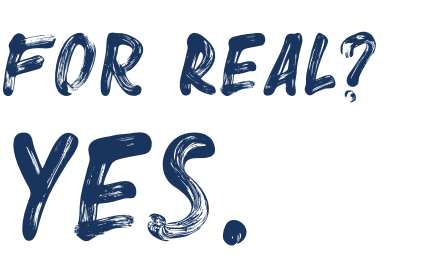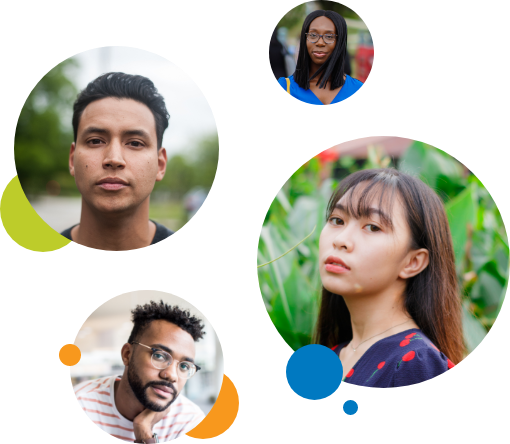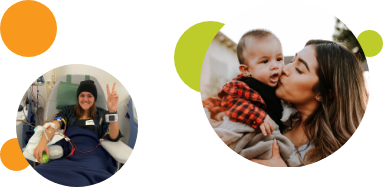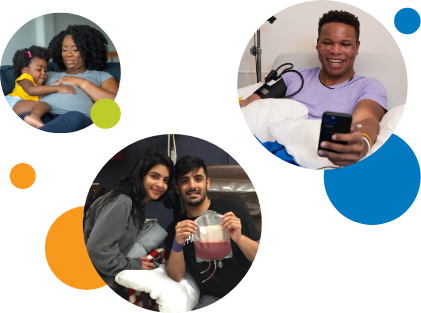
You probably have a few questions about what it takes to save a life. We get it, we’d have them too. Let’s talk about what you’ve heard and what’s really involved with donating blood stem cells.


What's Donating Like?
We’ve answered some of the most commonly asked questions.
You may have heard donating is really painful...
Discomfort and side effects vary from person to person
The most common side effects of a blood stem cell donation are headaches, nausea and tiredness from the daily shots for five days before it. For donors who have the outpatient surgery to donate bone marrow, there’s no pain during it and most say the feel sore or achy for a few days after.
You may be wondering if your donation really helps someone...
You could be the only person that could save a patient’s life
Donating your blood stem cells could help treat up to 70 diseases and blood cancers, as well as be the cure for a patient with sickle cell disease. Finding a match is complex. It is based on a type of tissue found on most of the cells in your body and because it is inherited, you’re most likely to match with someone who shares your ethnic background.
You may be thinking this goes against your family’s religious or cultural beliefs...
Donating blood stem cells is different than donating an organ
While every family's cultural and religious beliefs are different, it's important to know that donating blood stem cells is different than donating an organ. And by being a donor, you could potentially save someone's life.
You may be wondering where your donation goes and what we do with it…
It goes only to your patient
Right after you donate, a trained courier safely takes your blood stem cells to the patient’s hospital for the transplant.
You may be thinking patients are the only priority...
The safety and well being of both of patients and donors are our main focus
You’ll have a personal donor representative to answer any questions you have and we’ll follow up with you before, during and after donation. You’ve signed up to save someone’s life and we don’t take that lightly. We’re here to listen to you and make sure your needs are heard and met every step of the way.
You may have heard that surgery is required...
90% of donations involve no surgery at all
For most donors, it’s a peripheral blood stem cell (PBSC) donation, which is similar to donating plasma. The other 10% of the time entails a bone marrow donation, which involves outpatient surgery under anesthesia—meaning no pain during it and going home the same day.



How does donation affect my daily life?
The best way to find out is to hear from people who have donated.
You may be wondering how much work or school you’ll miss...
It takes a few hours a week for a few weeks
Between the phone calls, appointments and the donation itself, it typically takes about 20-30 hours total over a four-to-six-week period. About 60% of the time donors don’t need to travel during the process.
You may have heard it’s a long recovery...
Most donors go home the same day
Some feel a little sore or more tired than usual for about a week after donating, but most say they’re back to their regular lives within just a few days. Plus, donating doesn’t weaken your own body or immune system.
You may have heard you have to pay to donate...
It costs you nothing to donate
All of your medical and travel costs are covered. We can also help cover any lost wages due to donation. Plus, your insurance is not involved with the process at all.
You may be wondering if it affects having kids in the future...
Donating doesn’t impact your ability to have kids
There’s no evidence of negative effects on male or female fertility following donation. But as with any medical treatment or procedure, female donors hoping to become pregnant soon after donating should talk to their doctors.
You may be thinking your family won’t support your decision to donate...
Talking to your loved ones about donation can be hard - we’re here to help
Be sure to explain what’s involved and how saving someone’s life is something you can all be part of together.


More resources. More answers
More about the safety of donating blood stems cells:
A review from the National Library of Medicine
Research from the National Marrow Donor Program
Lower risk for serious effects and no increased risk for cancer
Note: NMDP is merely providing these resources for educational purposes and does not otherwise endorse the information contained in the articles.
Be the part of My NMDP community.
Connect with other donors and hear from patients whose lives have been saved because of people like you.
About NMDP℠
At NMDP℠, we believe each of us holds the key to curing blood cancers and disorders. As a global nonprofit leader in cell therapy, NMDP creates essential connections between researchers and supporters to inspire action and accelerate innovation to find life-saving cures. With the help of blood stem cell donors from the world’s most diverse registry and our extensive network of transplant partners, physicians and caregivers, we’re expanding access to treatment so that every patient can receive their life-saving cell therapy. NMDP. Find cures. Save lives.